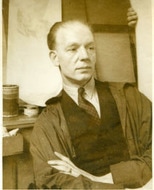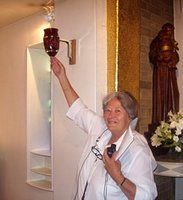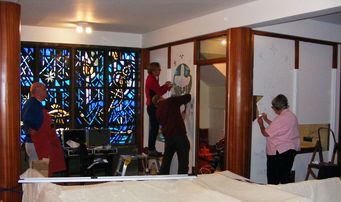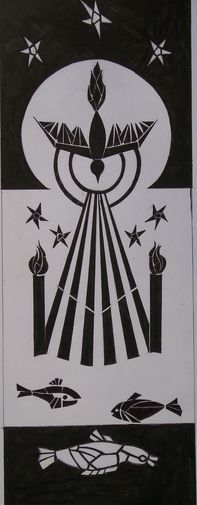Tour of St Richard's Church
Stained glass windows
On 13th November 2007 St Richard's was listed as a Grade II building by English Heritage, advised by the Catholic Church's Historic Churches Commission. The principal reason was the church's possession of one of the largest collections of Loire glass panels in Britain. These were commissioned from Gabriel Loire by the parish priest of 1962, Fr Langton Fox, who had close links with Chartres, which is twinned with Chichester. Chartres is the home of Loire glass and this studio produced the 62 composite and single panels which are set in the walls of St Richard's. The panels are of a technique known as dalle de verre, pioneered by the French stained glass designer Pierre Fourmaintraux, and adopted by Gabriel Loire.
Majella Taylor, a parishioner and Liveryman of the Worshipful Company of Glaziers and Painters of Glass, who knew the Loire family well, explained: 'The panels to provide the glass segments are about one inch (22mm) thick - individually coloured. The figures are made of small pieces produced by the glass maker hitting the blocks with a tungsten hammer. The chips are used to make up the image which is set in concrete.
'The panels have three large wall panels in the nave, north and south transepts with smaller panels depicting biblical scenes and also civic pictures reflecting the creative and recreational life of the City.
'It is remarkable how skilled the craftspeople were in creating facial details in the St Richard window - because each piece of glass had to be cut and then chipped to make the light and shade - instead of painting it like traditional glass, which is very skilled anyway. They had to chip it so that the lighter parts are thin glass and the dark thick glass.'
The small window beside the tabernacle, depicting the Archangel Barachiel, Our Lady and the infant Jesus, was a gift from the City of Chartres.
'The panels have three large wall panels in the nave, north and south transepts with smaller panels depicting biblical scenes and also civic pictures reflecting the creative and recreational life of the City.
'It is remarkable how skilled the craftspeople were in creating facial details in the St Richard window - because each piece of glass had to be cut and then chipped to make the light and shade - instead of painting it like traditional glass, which is very skilled anyway. They had to chip it so that the lighter parts are thin glass and the dark thick glass.'
The small window beside the tabernacle, depicting the Archangel Barachiel, Our Lady and the infant Jesus, was a gift from the City of Chartres.
Reconciliation Room
|
The glass walls of the Reconciliation Room, installed in 2010, were designed by Majella Taylor, with assistance from Antony Watts and colleagues, to complement the surrounding coloured Loire glass. Majella's dramatic concept symbolically shows the Alpha and Omega, and complements the existing Loire glass in style and design.The outline was projected onto a white fablon sheet, called a resist, adhering to the window and the design was drawn and cut into the plastic. The work was completed with a fine sand gun, powered by compressed air, which followed the image and removed the spoil.
The altar lamp was also engraved by Majella Taylor. |
Paintings

The paintings in the church are the work of David O'Connell (1898-1976), an artist who instituted the Catenians in Chichester and was their President. He served in the trenches in World War I and trained as a commercial artist, but his specialism was religious painting. He was Artistic Advisor to St Richard's.
As well as designing the font and other items, David provided St Richard's with the altar painting, the archangels that flank the tabernacle and the Stations of the Cross. The large painting behind the altar portrays Christ Crucified, with a montage of images reminding us that the Holy Mass is the continual re-presentation of Our Lord's sacrifice for our Salvation.
As well as designing the font and other items, David provided St Richard's with the altar painting, the archangels that flank the tabernacle and the Stations of the Cross. The large painting behind the altar portrays Christ Crucified, with a montage of images reminding us that the Holy Mass is the continual re-presentation of Our Lord's sacrifice for our Salvation.
The paintings of Our Lady of Walsingham and The Transfiguration, which hang in the West Gallery, are prints. The print of The Transfiguration was discovered unexpectedly in the Presbytery and that of Our Lady of Walsingham was gifted to the church by a lady in Ireland. The originals of these two paintings may be in the Church of Saints John Fisher and Thomas More in Eltham.
Further examples of David O'Connell's work can be seen in St Richard's School, Our Lady of Mount Carmel & St Wilfrid Church, Selsey, and further afield.
Further examples of David O'Connell's work can be seen in St Richard's School, Our Lady of Mount Carmel & St Wilfrid Church, Selsey, and further afield.
Furnishings
The furnishings of the church have been added over the years, many designed or created by craftsmen and women among our parishioners.
In the main church, the altar is of Tinos green marble and the steps are Belgian black fossil marble. The rear wall of the sanctuary is panelled in golden sycamore. The ambo was installed in October 2010 and replaced a wooden reading desk.
The white Portland Stone font, which stands at the foot of the sanctuary steps, is set in a slate gold glass mosaic and white Sicilian marble and was designed by David O'Connell. It originally stood in a baptistry in the Blessed Sacrament Chapel.
The white Portland Stone font, which stands at the foot of the sanctuary steps, is set in a slate gold glass mosaic and white Sicilian marble and was designed by David O'Connell. It originally stood in a baptistry in the Blessed Sacrament Chapel.
The Blessed Sacrament is reserved in a chapel once dedicated to Our Lady of Walsingham. The altar, also designed by David O'Connell, is flanked by his paintings of six archangels. The candlesticks were designed and made locally on the theme of a lily of Mary's virginity. Our Lady of Walsingham's statue is placed in the corner of the chapel. Originally, this statue was placed above the tabernacle.
The statues of the Sacred Heart and St Anthony of Padua were brought from the old St Richard’s Church.



